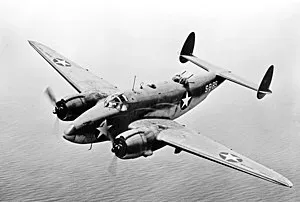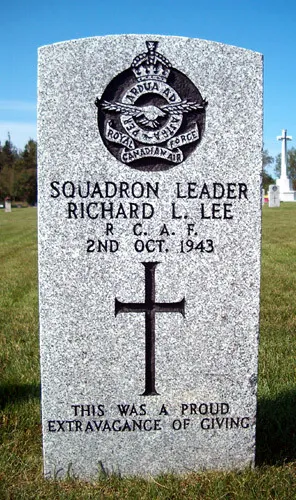Robinson, Edward Lapage (Flight Lieutenant)
Killed in Action 1943-October-02
Service
RCAF
Unit
145 Sqn- Squadron
Base
Rank
Flight Lieutenant
Position
Pilot
Service Numbers
J/9200
Crew or Other Personnel
Ventura 2160
Ventura serial: 2160

A Lockheed PV-1 Ventura
The Lockheed Ventura is a twin-engine medium bomber and patrol bomber of World War II.
The Ventura first entered combat in Europe as a bomber with the RAF in late 1942. Designated PV-1 by the United States Navy (US Navy), it entered combat in 1943 in the Pacific. The bomber was also used by the United States Army Air Forces (USAAF), which designated it the Lockheed B-34 (Lexington) and B-37 as a trainer. British Commonwealth forces also used it in several guises, including antishipping and antisubmarine search and attack.
The Ventura was developed from the Lockheed Model 18 Lodestar transport, as a replacement for the Lockheed Hudson bombers then in service with the Royal Air Force. Used in daylight attacks against occupied Europe, they proved to have weaknesses and were removed from bomber duty and some used for patrols by Coastal Command.
At the start of the war, Lockheed proposed military conversions of the Lodestar for the RAF as replacement for the Hudson reconnaissance aircraft and the Bristol Blenheim bomber. The first British order was placed in February 1940 for 25 Model 32 as bombers. This was followed by an order for 300 Model 37 with Double Wasp engines, then for a further 375 later in 1940. Lockheed needed more production capacity and nearby Vega Aircraft Corporation was contracted for building the Ventura.
The Ventura was very similar to its predecessor, the Lockheed Hudson. The primary difference was not in layout; rather, the Ventura was larger, heavier, and used more powerful engines than the Hudson. The RAF ordered 188 Venturas in February 1940, which were delivered from mid-1942. Venturas were initially used for daylight raids on occupied Europe but, like some other RAF bombers, they proved too vulnerable without fighter escort, which was difficult to provide for long-range missions. Venturas were replaced by the faster de Havilland Mosquito. The Venturas were transferred to patrol duties with Coastal Command as the Mosquito replaced them in bomber squadrons; 30 went to the Royal Canadian Air Force (RCAF) and some to the South African Air Force (SAAF). The RAF placed an order for 487 Ventura Mark IIs but many of these were diverted to the USAAF, which placed its own order for 200 Ventura Mark IIA as the B-34 Lexington, later renamed RB-34.
A total of 157 Ventura G.R. Mk. Vs were used operationally by the RCAF from 16 June 1942 to 18 April 1947 in the home defence coastal patrol role in both Eastern and Western Air Command. They were flown by 8, 113, 115, 145, and 149 Squadrons. A further 21 Ventura Mk. Is and 108 Ventura Mk. IIs were used in a training role at 1 Central Flying School, Trenton, Ontario, and at RCAF Station Pennfield Ridge, New Brunswick (RAF No. 34 Operational Training Unit) as part of the BCATP. A total of 21 Mk. Is, 108 Mk. IIs, and 157 G.R. Mk. Vs were in service during this period for a total of 286 aircraft. Wikipedia
Aircraft Images
Ventura 2160
Ventura G.R. Mk. V 2160
Ex USN, BuNo 33160. Based at RCAF Station Gander, Newfoundland. With No. 145 (BR) Squadron in Eastern Air Command, coded "S", by September 1943. Crashed at Torbay, Newfoundland on 2 October 1943, 3 crew killed. Ironically, the aircraft was being flown by senior pilots who were developing a training exercise for engine failure on take-off on instruments, in response to the fatal crash of 2169 a few weeks earlier. One propeller scrapped the ground after lift off, aircraft swerved and crashed. Destroyed by post impact fire. Official report theorized that pilots were distracted by lowering instrument hood just at lift off.Ex-USN, BuNo 33160. , also reported that the pilot raised the u/c prematurely and the a/c's nose dropped and the starboard propeller contacted the ground. All of the crew onboard perished. These included: Squadron Leader R.L. Lee (pilot), Flight Lieutenant E.L Robinson (2nd pilot) and Flying Officer A.F. Daunt (2nd pilot) Allocated to sub-Repair Depot in Gander, NF for reduction to spares and produce.1943-04-30 Taken on Strength 2019-08-20
1943-October-02 Accident: 145 Squadron Loc: Torbay Names: Daunt | Lee | Robinson
1944-03-19 Struck off Strength Cat “A†write-off 2022-01-21




